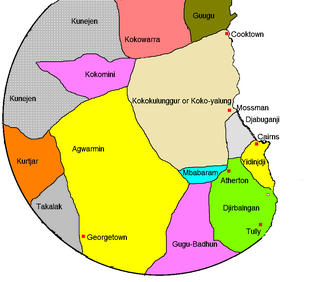Related Research Articles
Ngan'gi, formerly known as Ngan'gityemerri, and also known as Ngan'gikurunggurr, Moil/Moyle, Tyemeri/Tyemerri, Marityemeri, and Nordaniman, is an Australian Aboriginal language spoken in the Daly River region of Australiaʼs Northern Territory. There are three mutually intelligible dialects, with the two sister dialects known as Ngen'giwumirri and Ngan'gimerri.

The Western Desert language, or Wati, is a dialect cluster of Australian Aboriginal languages in the Pama–Nyungan family.
Warray (Waray) was an Australian language spoken in the Adelaide River area of the Northern Territory.
The Laragiya language, also spelt Larrakia, and also known as Gulumirrgin, is an Australian Aboriginal language spoken by just six people near the city of Darwin in northern Australia as of 1983. Only 14 people claimed to know the Laragiya language in 2016.

The Daly languages are an areal group of four to five language families of Indigenous Australian languages. They are spoken within the vicinity of the Daly River in the Northern Territory.
Malak-Malak, also known as Ngolak-Wonga (Nguluwongga), is an Australian Aboriginal language spoken by the Mulluk-Mulluk people. Malakmalak is nearly extinct, with children growing up speaking Kriol or English instead. The language is spoken in the Daly River area around Woolianna and Nauiyu. The Kuwema or Tyaraity (Tyeraty) variety is distinct.
Wambaya is a Non-Pama-Nyungan West Barkly Australian language of the Mirndi language group that is spoken in the Barkly Tableland of the Northern Territory, Australia. Wambaya and the other members of the West Barkly languages are somewhat unusual in that they are suffixing languages, unlike most Non-Pama-Nyungan languages which are prefixing.
The Ndjébbana language, also spelt Djeebbana and Ndjebanna and also known as Kunibidji, is a Burarran language spoken by the Gunavidji (Ndjebbana) people of North-central Arnhem Land in the Northern Territory of Australia.
The Burarra language is an Australian Aboriginal language spoken by the Burarra people of Arnhem Land. It has several dialects.
Marranj is an Australian Aboriginal language, a dialect continuum consisting of Maranunggu, Menhthe, and Emmi.
The Maringarr language is a moribund Australian Aboriginal language spoken along the northwest coast of the Northern Territory.
Mbariman-Gudhinma, one of several languages labelled Gugu Warra 'unintelligible speech' as opposed to Gugu Mini 'intelligible speech', is an extinct dialect cluster of Aboriginal Australian languages of the Cape York Peninsula in northern Queensland, Australia. Another one in the group is Wurangung, also known as Yadaneru or Jeteneru.

The Southern Daly languages are a proposed family of two distantly related Australian aboriginal languages. They are:
Guugu Yalandji, also spelt Kuku-Yalanji, is an Australian Aboriginal language of Queensland. It is the traditional language of the Kuku Yalanji people.
Wanggamala, also spelt Wanggamanha, Wangkamahdla, Wangkamadla, Wangkamanha, Wangkamana, Wonkamala, Wongkamala, Wonkamudla, and other variants, is an extinct Australian Aboriginal language of the Pama–Nyungan family, previously spoken in the Northern Territory around Hay River and to the south of the Andegerebinha-speaking area.

Wamin, also known as Agwamin or Ewamian, is an Australian Aboriginal language of North Queensland spoken by the Ewamian people. Wamin was traditionally spoken in the Etheridge region, in the areas around Einasliegh, Georgetown, and Mount Surprise.
Mithaka is an extinct Australian Aboriginal language in the Barcoo Shire of Western Queensland spoken by the Mitaka people.

The Western Daly languages are a small family of Australian aboriginal languages that share common grammatical forms. They are:
Martu Wangka is a variety of the Western Desert language that emerged during the 20th century in Western Australia as several Indigenous communities shifted from their respective territories to form a single community.
Kandjerramalh (Kenderramalh), also known as Pungupungu or Kuwema (Kuwama), is an Australian Aboriginal language from the Northern Territory in Australia. Apart from being closely related to Wadjiginy, it is not known to be related to any other language.
References
- ↑ Nordlinger, Rachel. 2017. "The languages of the Daly River region (Northern Australia)." In Michael Fortescue, Marianne Mithun, & Nicholas Evans (eds.), Oxford handbook of polysynthesis. Oxford: Oxford University Press.
- ↑ N11 Pungupungu at the Australian Indigenous Languages Database, Australian Institute of Aboriginal and Torres Strait Islander Studies
- ↑ Tryon, Darrell. 1980. "Pungupungu and Wadyiginy: Typologically Constrastive Dialects." In Bruce Rigsby and Peter Sutton (eds.), Papers in Australian Linguistics No.~13: Contributions to Australian Linguistics, 277-287. Canberra: Research School of Pacific and Asian Studies, Australian National University.
- ↑ N226 Giyug at the Australian Indigenous Languages Database, Australian Institute of Aboriginal and Torres Strait Islander Studies
- ↑ Tryon, Darrell T. "The Daly River Languages: A Survey". In Aguas, E.F. and Tryon, D. editors, Papers in Australian Linguistics No. 3. A-14:21-49. Pacific Linguistics, The Australian National University, 1968. doi : 10.15144/PL-A14.21